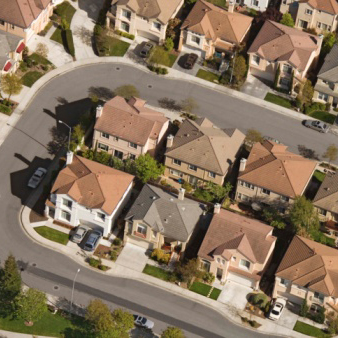How do you want the Bay Area to look in 2040?

Tonight the Metropolitan Transportation Commission (MTC) kicks off the first of nine “Plan Bay Area” workshops, aimed at gathering public input on plans for sustainable growth in the region. The planning agency is seeking comment on the Initial Vision Scenario, which was released by MTC and the Association of Bay Area Governments (ABAG) last month. This scenario is the first draft of the Bay Area’s Sustainable Communities Strategy, a planning document required under the state law, SB 375, which was passed in 2008 and requires planning regions throughout California to cut greenhouse gas emissions from cars by integrating land-use and transportation planning.
The Bay Area, Sacramento, and San Diego
have some of the most aggressive reductions targets: seven percent per capita by 2020 and 13-16% by 2035 (compared to 2005 levels). The South Coast (by far the biggest region, including Los Angeles, San Bernadino, Ventura, and other counties) is shooting for an eight percent reduction by 2020, and 13% by 2035.
“The Initial Vision Scenario really does center on accommodating the growth that we expect over the next generation within the existing urban footprint of the Bay Area,” said MTC public information officer John Goodwin. “Ninety-seven percent of all the new households that would be formed in the Bay Area over the next 25 years would be accommodated in already existing urban areas, which is pretty impressive.”
He said the new plan looks at all the expected growth in the region over the next couple decades and accommodates for all the people working in the Bay Area to be able to live in the Bay Area, instead of relying on commuters from other regions such as the Central Valley.
“That’s a big change,” Goodwin said. “Realizing that vision is a big step, and we’re a long ways from it.”
Last fall when the state Air Resources Board issued the regional greenhouse gas reductions targets under SB 375, opponents voiced concerns that they were too aggressive and that they would stifle economic development, trigger increased transportation costs for families, and hurt an already suffering construction industry.
But advocates say the targets won’t stop growth. In some cases, they’ll just encourage a different kind of growth. Denser communities closer to public transit – rather than sprawling new suburbs – could have a positive effect on the environment, air quality, and public health by reducing the number of miles people drive.
“The beauty of SB 375 is that it’s a performance standard,” said Amanda Eaken, deputy director for Sustainable Communities at the Natural Resources Defense Council in San Francisco. “It gives each region all the flexibility they need to choose the policies and programs that are most appropriate for their region.”
Tonight’s public meeting on the Initial Vision Scenario for Plan Bay Area is in Mountain View. Next week’s forums will be in San Francisco and at the San Mateo Public Library. There is a calendar of the public workshops and their locations on the One Bay Area website. The final draft of the plan is not expected until 2013.
You can see more coverage of how the Bay Area, and the rest of California, is grappling with the opportunities and challenges of sustainable growth, on our Miles to Go series page.
2 thoughts on “Planners Seek Public Input on Bay Area Growth”
Comments are closed.

This statement is partially inaccurate:
“The Bay Area has some of the most aggressive reductions targets: seven percent per capita by 2020 and 13-16% by 2035 (compared to 2005 levels). Sacramento, San Diego, and the South Coast (by far the biggest region, including Los Angeles, San Bernadino, Ventura, and other counties) are shooting for an eight percent reduction by 2020, and 13% by 2035.”
The Bay Area has the second most aggressive targets, with -7% by 2020 and -15% by 2035; SACOG (Sacramento) has the most aggressive targets, which seek -16% by 2035.
I understand this information is difficult to find, as it is not actually posted on the SB 375 page of the ARB website in an easy-to-find location. I found that this page, however, does host the most current, accurate info:
http://transbayblog.com/2010/09/24/air-resources-board-adopts-final-targets-for-sb-375/
Hi Garlynn,
Thanks for your comment and for the clarification.
I have changed the text to more accurately reflect what I meant to say, which was, “The Bay Area, Sacramento, and San Diego have some of the most aggressive reductions targets: seven percent per capita by 2020 and 13-16% by 2035 (compared to 2005 levels). The South Coast (by far the biggest region, including Los Angeles, San Bernadino, Ventura, and other counties) is shooting for an eight percent reduction by 2020, and 13% by 2035.”
Thanks also for sharing the helpful link to the TransBay blog.
Gretchen